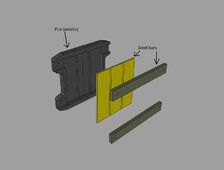I have tons of steel profiles in my warehouse and i am used to just chop some and weld them together when i need something like this.
You are right about the fire risk issue. But i dont know enough yet about lithium fire risks and ways to contain it. I was thinking about some type of enclosure, i am going to have to study this as well. Thanks for your feeback.
In California, the state has embarked along with the utility owners and investors to build massive lithium battery storage facilities. the state has an excess of daytime PV energy production, but without battery storage, needs to burn gas to generate electricity, ergo the battery storage facilities.
So I undertook a googling one day and it seems that the best way to put out lithium battery fires is containment cabinets, separating batteries from each other AND flooding them with water. NFPA 855 addresses lithium batteries and talks about residence locations. Stacks limited to 20 kW, 20 kW stacks separated by 3 feet from each other and walls, no locations in living areas, near windows or doors or in closets. If in garages, the walls should not be open studs.
The UL9540a is a battery testing standard for run away fire containment of a battery and UL9540 is a standard for communication between the battery BMS and inverter to shut down charging currents to prevent fires. When the inverter and battery bank together meet the standard, the local authority will allow a larger bank of batteries than NFPA855.
In your case, unless you can place the banks into some kind of containment cabinet, the next best thing is going to be to install a fire suppression water based system. Many are available, especially if you look for them for California due to wildfire risk here.
In my case, my batteries and inverter meet UL9540a and UL9540 as well as the batteries are in metal cabinets which are UL lister for the batteries and fire suppression and indoor and outdoor rated. Locked to prevent tampering too and ventilated, with optional heating and cooling. All designed to prevent fires.
Total cost for 41 kW of batteries and cabinets $13.5K before Federal tax credit. And the 10 year over 6000 cycle warranty.
You may be saving some money and of course, I like you love to do projects. But some things for me have a line like DIY batteries in a high wildfire risk zone and putting pilings into a river bed to build my own dock.
You may have done a great job, but you have little to no protection from an actual cell that fails in terms of containment. Your only real means of protection is visual cell inspection daily and then shut that cell down and remove from the pack. That won't be fun.
Finally, don't take all this as personal. It is really written for other forum members to gain an understanding of the advantages and problems faced if doing a DIY and think of the potential for property and life loss in case of failure.





